English | Français
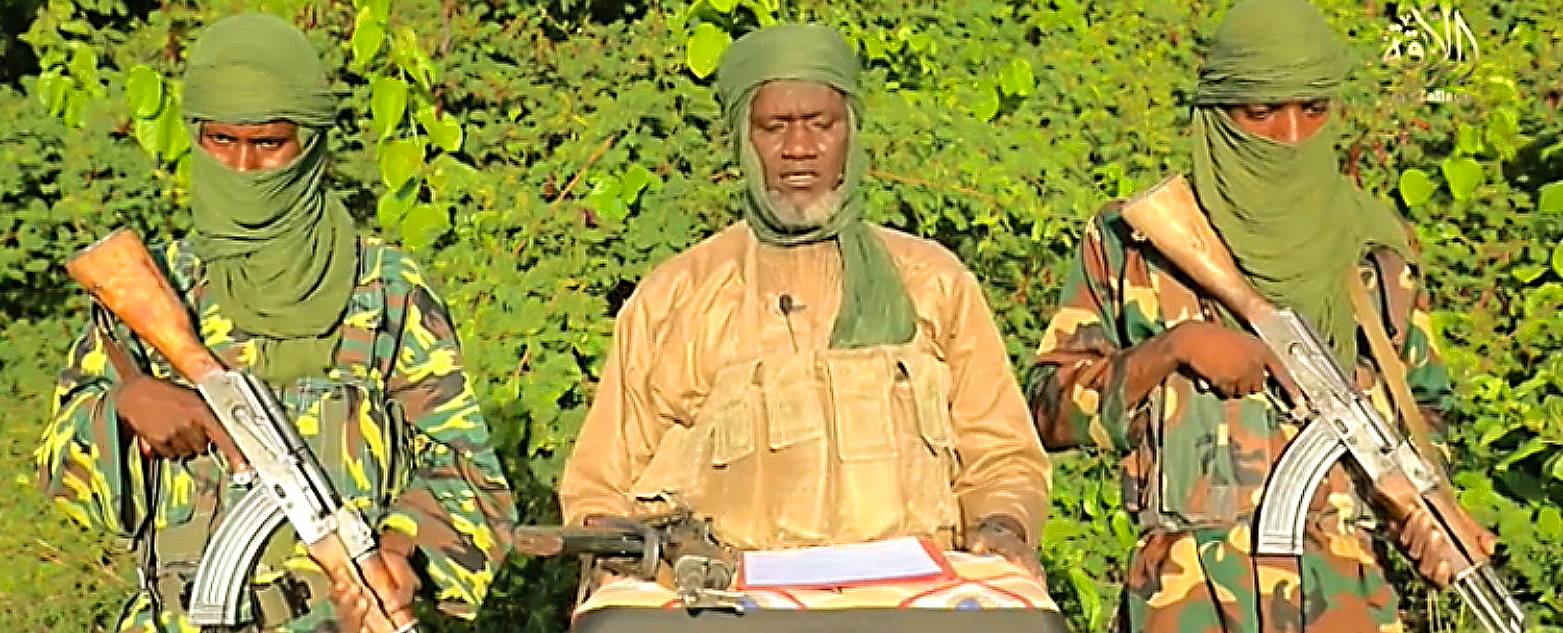
Maçina Liberation Front leader Amadou Koufa (center) in a video released by the group in February 2023.
The Sahel has held the designation of the most lethal theater of militant Islamist violence in Africa for 4 years in a row. The Sahel accounted for 55 percent of all such fatalities, costing the lives of 10,400 people out of a total of 18,900 deaths continentally. An estimated 67 percent of all non-combatants killed by militant Islamist groups in Africa are in the Sahel.
Militant Islamist violence in the Sahel is not uniform, but marked by concurrent patterns of expansion, plateau, and modest reductions.
Three Sahelian countries—Mali, Burkina Faso, and Niger—are the focal point of militant Islamist violence in the region. This violence has widened in scale and scope in recent years. Fatalities linked to these groups are more than two and half times the levels seen in 2020 when the first military coup in Mali occurred. Subsequent coups in Burkina Faso and Niger have also been followed by deteriorating security. Militant Islamist groups control more territory and transportation arteries in the three countries than at any point since the insurgencies began more than a decade ago. These figures are likely an undercount as the military juntas in all three countries have systematically intimidated journalists for reporting on military setbacks.
The widening security threat in the Sahelian countries is resulting in growing pressure on the neighboring coastal West African countries of Benin, Togo, Ghana, Côte d’Ivoire, Guinea, Senegal, and Mauritania.
Militant Islamist violence in the Sahel is not uniform but marked by concurrent patterns of expansion, plateau, and modest reductions. The divergent trends merit deeper analysis to better understand the focal points, actors, and objectives of the different extremist groups driving this violence.
Multiple Groups, Multiple Agendas
The threat from militant Islamist groups in the Sahel is multidimensional with distinct groups each operating with their own unique leadership, organizational structure, objectives, fundraising, recruitment, and tactics. In 2017, several of these militant groups with affiliations to al Qaeda joined a coalition called Jama’at Nusrat al Islam wal Muslimeen (JNIM) to coordinate their activities and shield the composite entities from scrutiny.
JNIM’s most active group is the Maçina Liberation Front (FLM) led by the charismatic Fulani preacher Amadou Koufa. As it has consolidated its grip on territory around its stronghold in central Mali, the FLM has used this base as a launching pad to expand into southern Mali and Burkina Faso. This includes a high-profile attack on a gendarmerie base in the capital city of Bamako in September 2024, in which dozens of soldiers were killed and the presidential plane set on fire.
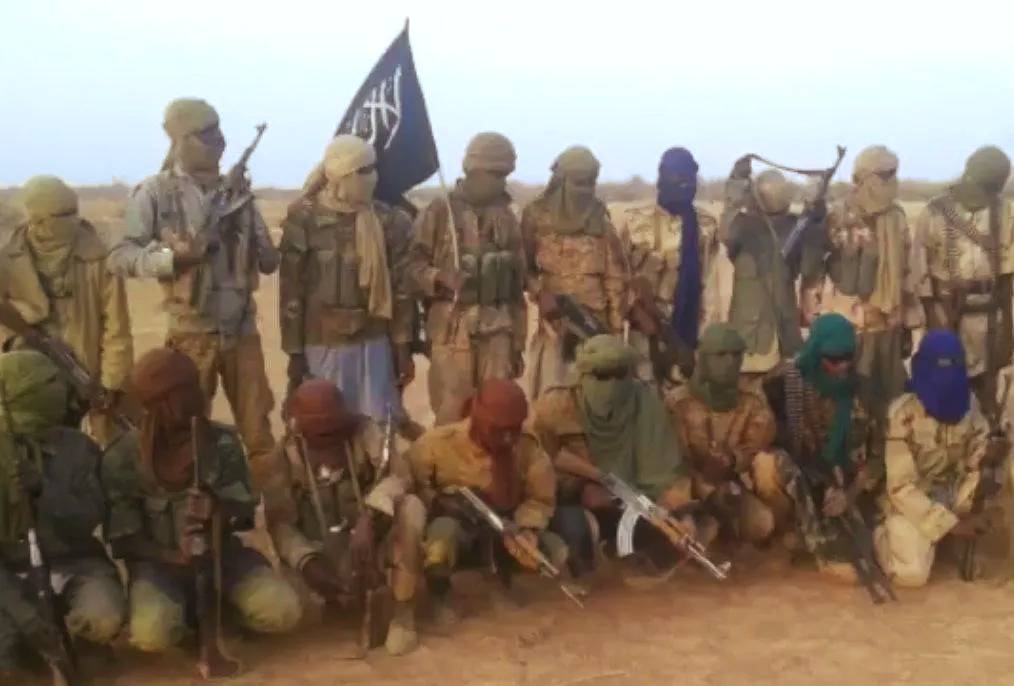
Ansaroul Islam militants in northern Burkina Faso, date unknown. (Photo: screenshot)
Other JNIM contingents, like Ansaroul Islam and Katiba Hanifa, have sustained their activities in northern and eastern Burkina Faso, consolidating their positions there and expanding further south into the border areas of Togo and Benin.
Militant Islamist groups first gained a foothold in the Sahel in northern Mali two decades ago with the emergence of fighters from al Qaeda in the Islamic Maghreb (AQIM), who had been operating in Algeria. Building on this growing influence, a Tuareg leader from Kidal, Iyad ag Aghali, founded Ansar Dine in 2011. Ansar Dine subsequently became a founding member of JNIM, with ag Ghali recognized as its official emir.
Another AQIM offshoot led by Abu al Bara al Sahrawi rebranded itself as the Islamic State in the Greater Sahara (ISGS) in 2015, pledging allegiance to the Islamic State. Building on its de facto territorial control in the northern Malian region of Ménaka (which was consolidated after the withdrawal of the United Nations Multidimensional Integrated Stabilization Mission in Mali (MINUSMA) in December 2023), ISGS has increased its violent attacks in western Niger where fatalities have jumped 66 percent (to 1,318 deaths) over the last year. ISGS militants have also maintained their pressure around the northern Malian city of Gao and the Oudalan and Séno Provinces of northern Burkina Faso where they have at times clashed with JNIM-affiliated militants. The concentration of ISGS activities in this area suggests a carving out of territory by ISGS from JNIM, with ISGS operating as the main actor in Ménaka and western Niger.
Sifting through these competing actors and areas of influence, three broad patterns of militant Islamist violence in the Sahel emerge:
- Zones of rising militant Islamist group violence
- Zones of militant Islamist group entrenchment
- Threats to the border areas of coastal West African countries
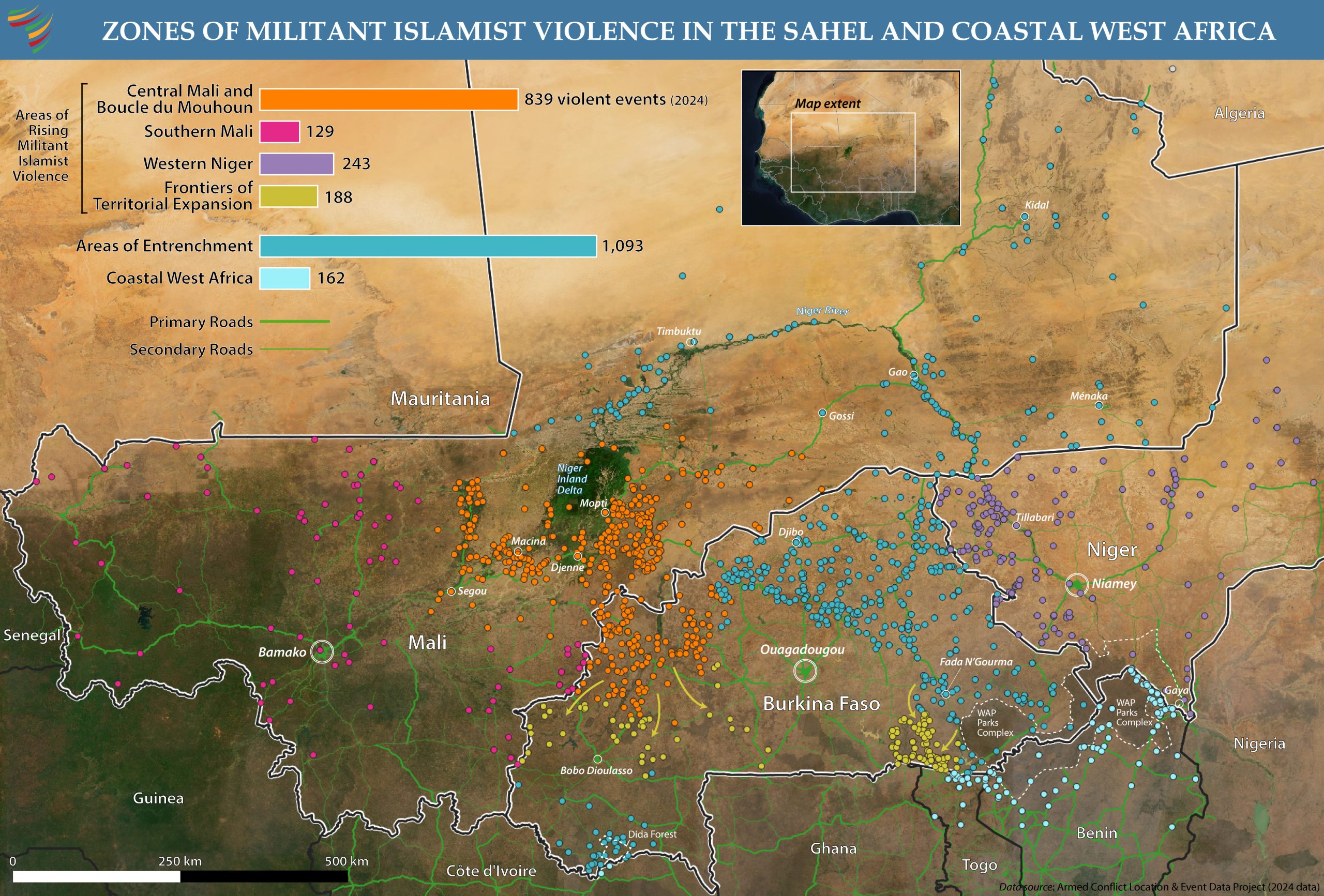 Click for printable high-resolution PDF.
Click for printable high-resolution PDF.
Zones of Rising Militant Islamist Violence
Zones of rising militant Islamist violence account for 42 percent of the fatalities observed in the Sahel over the past year. Three distinct areas stand out.
Central Mali and Boucle du Mouhoun, Burkina Faso [See ● dots on Zone Map]
FLM remains most deeply entrenched in Central Mali and the neighboring region of Boucle du Mouhoun in northwest Burkina Faso. FLM has mobilized recruitment by exploiting economic and political tensions between pastoralist and farming communities in central Mali. FLM targets Fulani youth by presenting itself as sympathetic to the pastoralists’ grievances.
FLM has mobilized recruitment by exploiting economic and political tensions between pastoralist and farming communities.
As FLM militants have pushed into Burkina Faso, they have engaged in livestock theft, the burning of villages, and destruction of bridges, further impoverishing and displacing communities that have resisted their presence. This is part of a trend in which the FLM has established itself through violence and, in the process, gained control of greater swathes of territory, transportation arteries, and economic activity.
- The central Malian regions of Segou and Mopti saw more violent events (605) and fatalities (1,557) than in any previous year.
- The 38-percent increase in fatalities registered in the Boucle du Mouhoun Region of Burkina Faso (resulting in 1,199 deaths) reflected the largest year-on-year increase of any region in the country. In the year prior to Burkina Faso’s two military coups in 2022, Boucle du Mouhoun reported 58 fatalities.
- Considering Boucle du Mouhoun, Mopti, and Segou, there has been a 165-percent increase in fatalities (from 1,038 to 2,756) linked to militant Islamist groups from 2021 to 2024.
- Roughly 1 out of every 3 fatalities linked to militant Islamist groups in Mali and Burkina Faso took place in either Boucle du Mouhoun, Mopti, or Segou in 2024.
As FLM expands southward from Central Mali and Boucle du Mouhoun into southwest Burkina Faso, it poses a growing threat to Bobo Dioulasso—Burkina Faso’s second largest city (with a population of 1.2 million) and economic hub in the subregion. Taking territory surrounding Bobo Dioulasso would enable FLM to link up its core contingent of forces with FLM-affiliated fighters already established in Burkina Faso’s southwest near the border with Côte d’Ivoire. This would also place FLM in a position to push westward toward Bamako and the border with Guinea.
Vanguard FLM Force on the Ivorian Border
[See ● dots in southwestern Burkina Faso on Zone Map]
An offshoot group of FLM-linked militants has entrenched itself around the Dida Forest in southwestern Burkina Faso’s Cascades Region since 2019. These militants have struggled to establish a foothold in northern Côte d’Ivoire, but they have tapped into smuggling and trafficking networks as well as artisanal mining sites in the area. Led by a commander using the nom de guerre “Hamza,” this militant Islamist group has recruited from marginalized populations, intermixed with criminal actors, and established ongoing revenue streams that have made the violent extremists more self-reliant.
Southern Mali [See ● dots on Zone Map]
FLM is also using its base in central Mali and Boucle du Mouhoun to stage more attacks into southern Mali. FLM’s expansion into this region represents an alarming development given that 60 percent of Malian citizens reside in southern Mali. The region is also the agricultural heart of the country, where cotton cultivation provides livelihoods for over 4 million people, roughly 20 percent of the population. Southern Mali is also the area in which most industrial scale mining occurs, making it strategically important to the country’s economy. Gold dominates Mali’s mining sector, representing more than 90 percent of the country’s mineral production. Deposits of diamonds, rock salt, phosphates, semi-precious stones, bauxite, iron ore, and manganese are also mined in this region. Taken together, Mali’s top two exports, gold and cotton, make up around 80 percent of export earnings in Mali’s economy. The deteriorating security situation in southern Mali, therefore, portends mounting disruptions for the country.
- Bamako suffered a major attack in September 2024 when FLM forces hit a gendarmerie school, resulting in the loss of dozens of soldiers. The past year saw nearly triple the number of violent events occurring within 150 km of Bamako compared to 4 years ago.
- No other zone in the Sahel recorded a sharper increase in militant Islamist group activity than southern Mali in the past year, with fatalities linked to violent events jumping by 87 percent (from 168 to 314).
Western Niger [See ● dots on Zone Map]
The geographically strategic location of western Niger—abutting both central Mali and eastern Burkina Faso—makes it a highly influential zone of control for militant Islamist groups. Since the July 2023 military coup in Niamey, violent events and associated fatalities have dramatically increased in this zone as both JNIM and ISGS carve out their areas of influence in Niger.
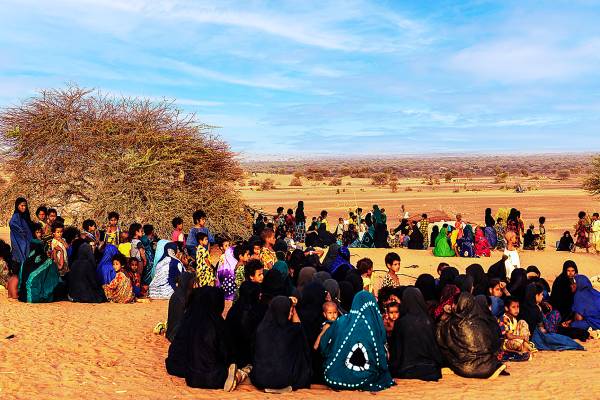
IDP camp in Ménaka, Mali. (Photo: Minusma)
JNIM affiliates Ansaroul Islam and Katiba Hanifa have targeted the commercial corridors facilitating trade between Ouagadougou and Niamey. Building on its base in Mali’s Ménaka Region, ISGS has also rapidly expanded its control of territory in western Niger since the coup. ISGS has mounted increasingly lethal attacks in the Tillaberi Region. This has enabled ISGS to severely disrupt northbound transportation between Niamey and Gao in Mali.
ISGS and Ansaroul Islam are both also targeting different sections of the primary westbound artery from Niamey to Djibo in Burkina Faso. Meanwhile, a recently emerged shadowy JNIM group referred to as Katiba Hanifa disrupts a major commercial transit route that connects Niamey to Ouagadougou through the eastern city of Fada N’Gourma. These developments present a growing security and economic threat to Niamey as it finds itself increasingly encircled by the two extremist factions.
ISGS has also entrenched itself in areas of northern Burkina Faso in Oudalan and Seno Provinces where the borders of Burkina Faso, Mali, and Niger meet. The collective effect of these escalations is a steadily deteriorating security situation in western Niger.
- Fatalities linked to militant Islamist violence in western Niger have increased 66 percent from 793 in 2023 to 1,318 in 2024. These fatalities represent a marked increase in lethality as the number of violent events increased only marginally from 230 to 243 over the same period.
- Niger’s Tillaberi Region, which borders both Burkina Faso and Mali, recorded 92 percent of the fatalities (1,212) linked to militant Islamist groups (primarily ISGS and Ansaroul Islam) in western Niger in 2024.
- Long focused on Ménaka in northern Mali, ISGS is now linked to roughly the same number of violent events in western Niger (145) as in northern Mali (149). By stretching its influence southward both west and east of Niamey, ISGS militants may be seeking to encircle the Nigerien capital while also gaining control over supply routes to northwest Nigeria.
- JNIM (likely Ansaroul Islam), meanwhile, has been expanding its violent activity in western and southwestern Niger. It was linked to 598 fatalities in 2024, a 237-percent increase over the previous year.
- Roughly 90 percent of these JNIM-linked attacks in western Niger were concentrated in two areas: the region bordering eastern Burkina Faso and the border areas of northern Benin. The latter attacks are likely linked to Katiba Hanifa.
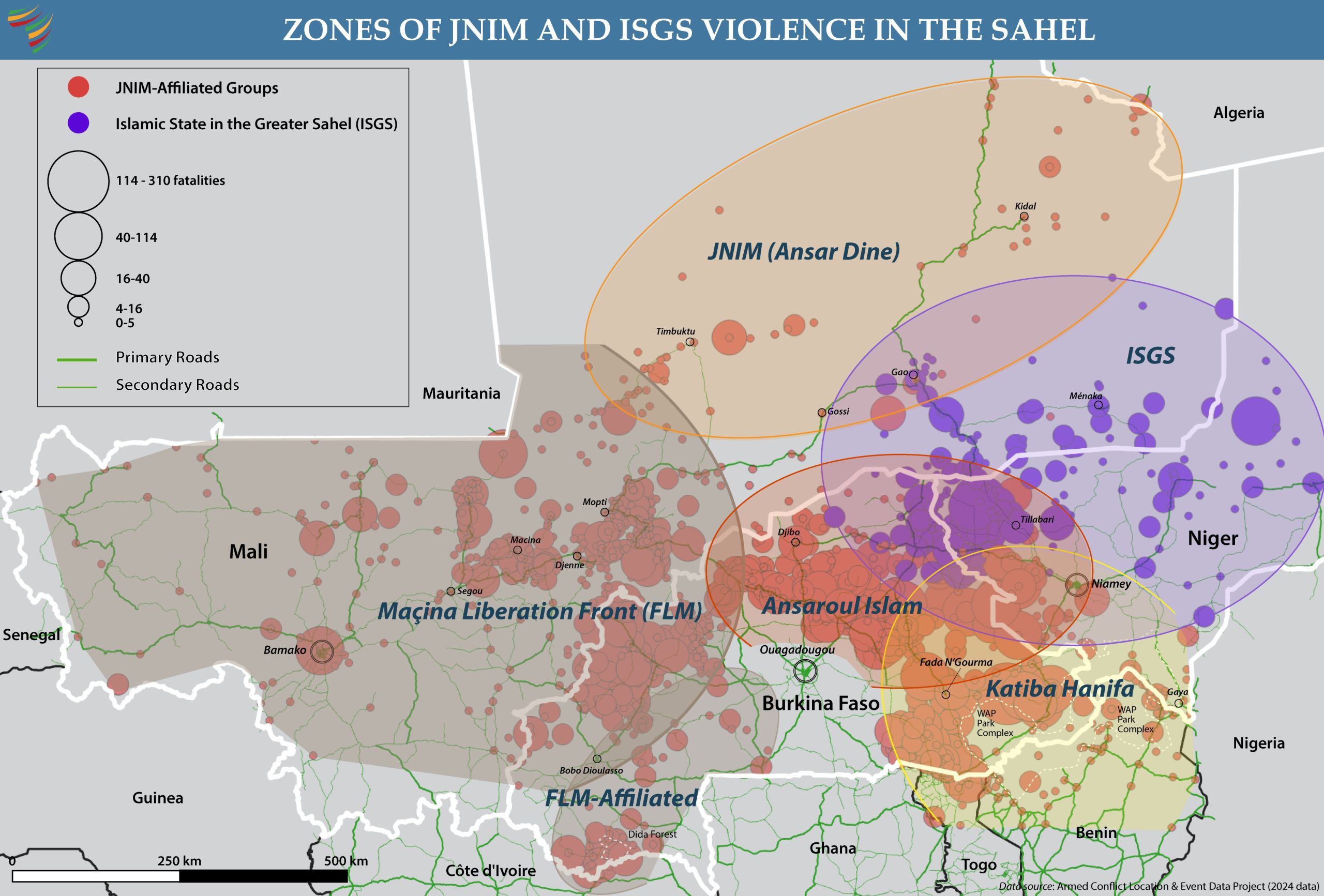 Click for printable high-resolution PDF.
Click for printable high-resolution PDF.
Areas of Militant Islamist Group Entrenchment—Northern Mali and Northern Burkina Faso [See ● dots on Zone Map]
Several regions of the Sahel saw either plateauing figures of militant Islamist group violence or modest abatements. For example, northern Mali and northern Burkina Faso, excluding Boucle du Mouhoun, saw slight declines in the number of violent events and fatalities from the record levels of violence experienced in 2023. Rather than an improving security situation, however, these plateaus appear to reflect the entrenchment of control over these northern territories where JNIM (likely Ansar Dine and Ansaroul Islam) and ISGS have long maintained a presence. These zones of entrenchment account for 48 percent of the fatalities in the Sahel, underscoring the sustainment of a high degree of militant Islamist violent activity.
Even in parts of the Sahel where the recorded events of violence have plateaued or decreased, high levels of instability persist.
In northern Mali, where Ansar Dine has been operating for two decades, militants closely linked to Iyad ag Aghali are able to control main thoroughfares and road arteries. Deadly attacks are so common that civilians are forced to rely on military escort, though these convoys are routinely ambushed by militants. The sparsely populated countryside and challenging terrain offer safe haven to the militants who have besieged dozens of urban centers.
In northern Burkina Faso, JNIM-affiliated Ansaroul Islam led by Jafar Dicko has entrenched itself around the city of Djibo. This area of Burkina Faso, comprising the Nord, Sahel, and Centre-Nord Regions, suffered more than 25 percent (2,674) of all fatalities in the Sahel theatre.
Northern Burkina Faso has also seen multiple incidents in which militants have killed hundreds of civilians and soldiers in single attacks over the past year. In June 2024, likely Ansaroul Islam militants killed more than 100 soldiers in an attack on a military base in Mansila in the Sahel Region of northeastern Burkina Faso. In Centre-Nord Region, militants attacked Barsalogho residents who were digging defensive trenches under the supervision of soldiers and Volunteers for the Defense of the Homeland (VDP) militiamen. Some 400 civilians were believed to be killed in this August 2024 attack. In the same month, suspected Ansaroul Islam militants ambushed a food supply convoy under security force escort in Est Region and killed roughly 150 soldiers and allied militiamen as well as dozens of civilians. These events are among the worst single-day fatality events ever recorded in Burkina Faso’s history.
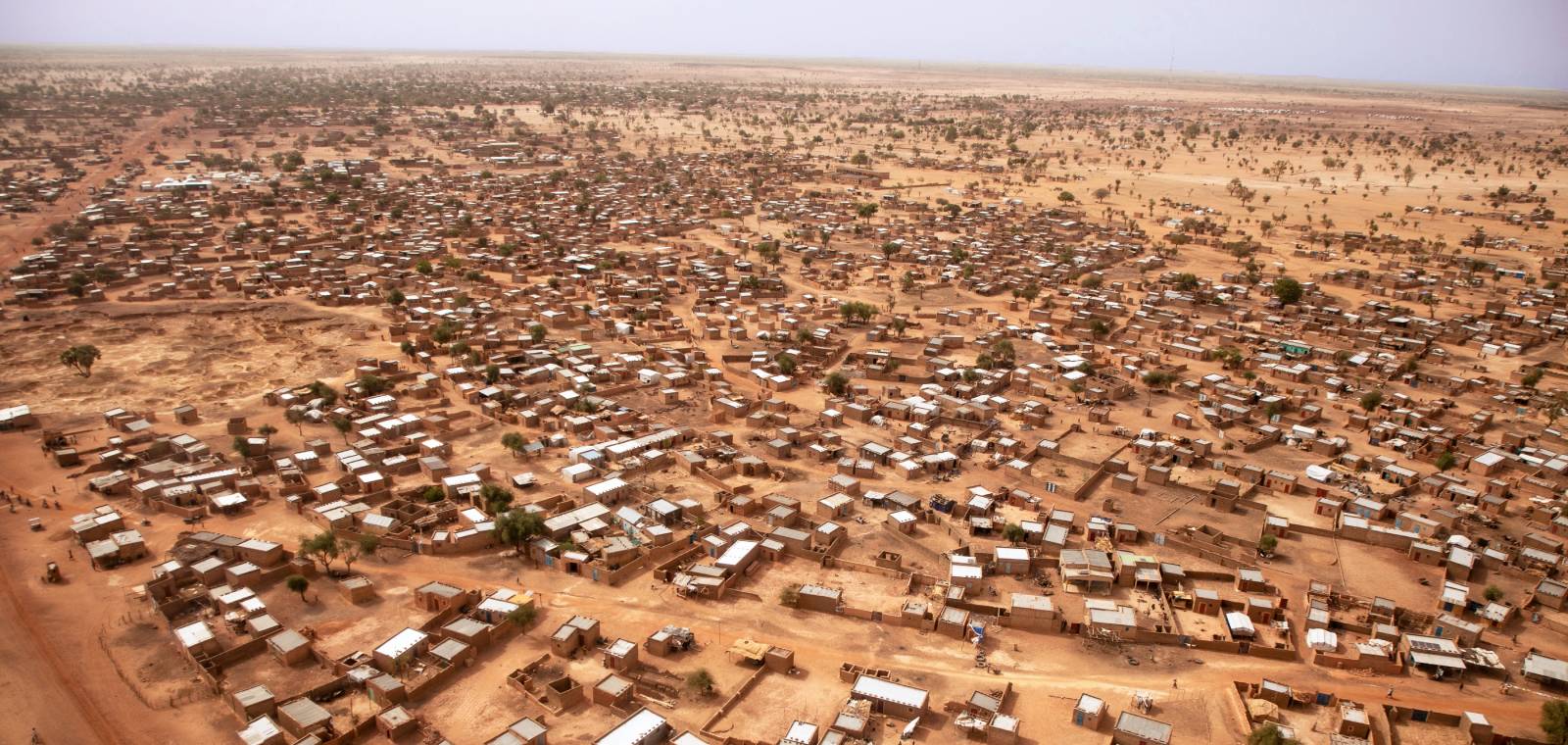
The town of Barsalogho, Burkina Faso. (Photo: AFP)
From its base in northern Burkina Faso, Ansaroul Islam has been able to expand south and east, linking up with Katiba Hanifa in southeastern Burkina Faso while also placing growing pressure on Ouagadougou.
In the tri-border zone between Mali, Burkina Faso, and Niger contested by Ansaroul Islam and ISGS, civilians and security forces have come under persistent attack. Attacks on Médecins Sans Frontières (MSF) health workers have led the humanitarian organization to suspend its activities in multiple locations in this region including Djibo in northern Burkina Faso and Ménaka in northern Mali. In Ménaka, ISGS has effectively besieged several municipalities to assert its de facto control over the territory. This has resulted in a 28-percent increase in the number of displaced persons in the region and an 85-percent increase in the number of refugees fleeing Ménaka for Niger over the last year.
Blockades by ISGS, FLM, Ansaroul Islam, and Ansar Dine around Kidal and Timbuktu have pushed regions of northern Mali and northern Burkina Faso into emergency levels of food insecurity, causing millions to suffer acute hunger. Throughout the region, dozens of municipalities remain under siege, making it difficult for food and other necessities to reach a growing population of forcibly displaced persons.
In short, even in parts of the Sahel where the recorded events of violence have plateaued or decreased in aggregate, high levels of instability persist.
Threats to Coastal West Africa [See ● dots on Zone Map]
The continued expansion of militant Islamist violence in Mali, Burkina Faso, and Niger has resulted in an increased number of attacks along and beyond the borders of coastal West African countries, from Mauritania to Nigeria. Most attention has focused on Benin and Togo, which have respectively suffered 153 and 96 militant Islamist group-linked fatalities in 2024. However, there have also been dozens of violent extremist attacks in southern Mali within 50 km of the borders of Mauritania, Senegal, and Guinea. Until recently, these border zones reported little to no activity.
- Fatalities linked to militant Islamist group violence within 50 km of or over the borders of coastal West Africa increased 27 percent from 1,601 to 2,036 between 2023 and 2024. This is even though violent events in the same zone dropped slightly from 455 to 449 over the same period.
- The most notable increase occurred in Mali, where the number of fatalities linked to militant Islamist groups within 50 km of the border with Mauritania, Senegal, and Guinea shot up from 23 in 2023 to 125 in 2024.
- Meanwhile in southwestern Burkina Faso, JNIM-affiliated militants sustained their threat on the border of northern Côte d’Ivoire. Fatalities linked to these groups increased 27 percent from 267 to 361 in 2024.
Southeastern Burkina Faso [See ● dots on Zone Map]
Pressure on coastal West African countries has been particularly pronounced in the borderlands and jointly protected areas like the WAP parklands, which includes territory from Benin, Burkina Faso, and Niger and is near Togo, Ghana, and Nigeria. The parks’ transboundary location amplifies the complexity this security challenge poses for regional cooperation.
JNIM-affiliate Katiba Hanifa has established itself in southeastern Burkina Faso since 2018. The militants use safe havens in the WAP parklands to infiltrate Benin and Togo while simultaneously expanding west in Burkina Faso along the border with Togo and Ghana.
Katiba Hanifa targets some of the major commercial transit corridors for the region, seeking to exploit and cut off trade flow from coastal ports in Cotonou and Lomé. In 2024, militants heavily targeted both road networks and key border crossings, like Gaya in Niger. This poses a serious threat to Niamey. The Cotonou corridor handles more than 50 percent of Niger’s trade, with an additional 20 percent of Niger’s imports passing through Burkina Faso along routes that Katiba Hanifa has similarly targeted.
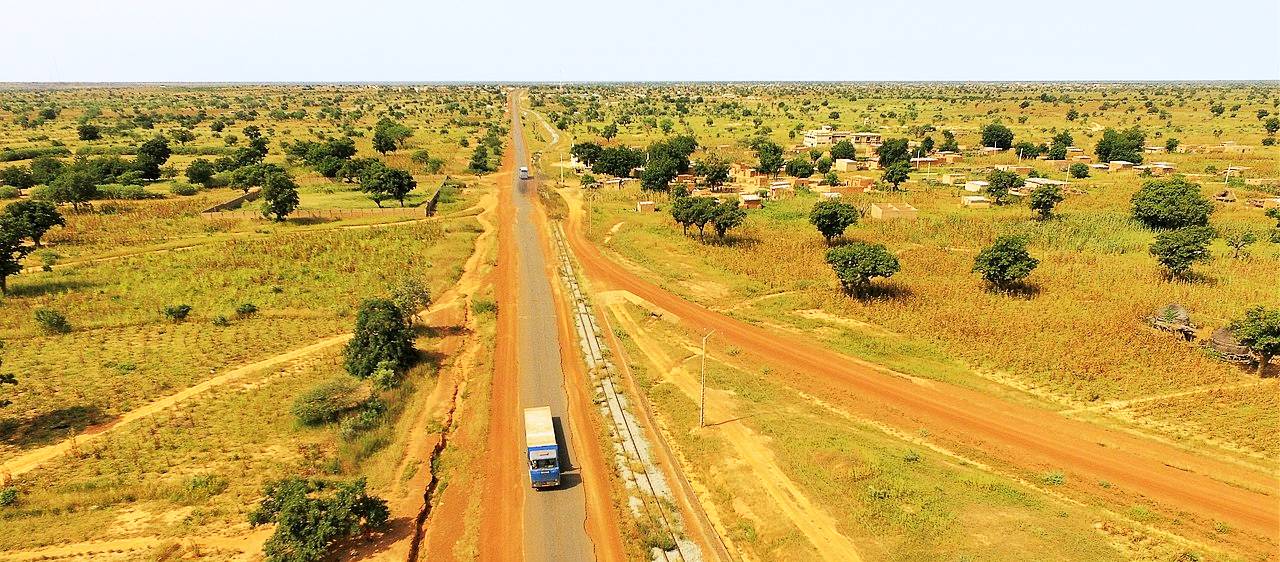
Route Nationale 7 (RN7) in Niger between Gaya and Dosso. (Photo: NigerTZai)
In addition to disrupting trade and tapping into the adjacent smuggling and trafficking networks, the militant Islamists have sought to exploit artisanal gold mining sites around the W-Arly-Pendari (WAP) reserve. The parklands are also an important area for pastoralists moving their herds to markets in coastal West Africa or seeking pasture on which to graze their livestock. Katiba Hanifa militants regularly extort livestock herders who move through and around the parklands, adding another important revenue stream to their activities.
As Katiba Hanifa expands westward from its base in southeast Burkina Faso it poses a growing threat to the northern borders of Ghana. Should Katiba Hanifa be able to expand westward across southern Burkina Faso, JNIM-affiliated militants would effectively surround Ouagadougou.
- Fatalities linked to militant Islamist groups (likely Katiba Hanifa) in Burkina Faso’s Est Region—which includes the WAP complex and borders Niger, Benin, and Togo—nearly tripled in the last 2 years to 1,472 deaths.
- In the Centre-Est Region of Burkina Faso, bordering Togo and Ghana, there was a 266-percent increase in fatalities (to 612 deaths) in the same time span.
The continued southward and westward push of militant Islamist groups is heightening the pressure on the borders of all the coastal West African countries. This will require the redoubling of proactive security and governance outreach measures in the northern regions of these countries to mitigate this threat and hold the line.
Additional Resources
- Africa Center for Strategic Studies, “Militant Islamist Groups in Africa Sustain High Pace of Lethality,” Infographic, February 18, 2025.
- Africa Center for Strategic Studies, “Militant Islamist Groups Advancing in Mali,” Infographic, September 24, 2024.
- Daniel Eizenga and Amandine Gnanguênon, “Recalibrating Coastal West Africa’s Response to Violent Extremism,” Africa Security Brief No. 43, Africa Center for Strategic Studies, July 2024.
- Africa Center for Strategic Studies, “Burkina Faso Crisis Continues to Spiral,” Infographic, August 29, 2023.
- Africa Center for Strategic Studies, “Five Zones of Militant Islamist Violence in the Sahel,” Infographic, September 26, 2022.
- Daniel Eizenga and Wendy Williams, “The Puzzle of JNIM and Militant Islamist Groups in the Sahel,” Africa Security Brief No. 38, Africa Center for Strategic Studies, December 2020.

